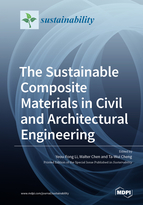The Sustainable Composite Materials in Civil and Architectural Engineering
A special issue of Sustainability (ISSN 2071-1050). This special issue belongs to the section "Sustainable Engineering and Science".
Deadline for manuscript submissions: closed (31 July 2022) | Viewed by 26923
Special Issue Editors
Interests: seismic retrofit of RC structures; fiber-reinforced polymers; fiber-reinforced concrete
Special Issues, Collections and Topics in MDPI journals
Interests: soil erosion; machine learning; geotechnical engineering
Special Issues, Collections and Topics in MDPI journals
Interests: geopolymer; mineral processing; recycling; waste treatment; functional materials
Special Issue Information
Dear Colleagues,
The world is facing uncertain times with the current spread of the COVID-19 pandemic. We hope you are safe and well. During this difficult time, everyone is vulnerable, and one cannot help but wonder what may be coming ahead. The deadly virus not only means our personal safety is at risk but so is our species' sustainable future. Times like this remind us of what we could have done to protect the environment and our own health. Therefore, why not start by working on a Special Issue of "The Sustainable Composite Materials in Civil and Architectural Engineering"? In this Special Issue, we would like to solicit your innovative ideas and work on the design, analysis, retrofit, inspection, and repair of all types of infrastructures and engineering structures ranging from hospital quarantine tents to historical and heritage structures, as well as from root-reinforced soil slopes to geosynthetic-reinforced soil structures using sustainable composite materials. The composite material is not limited to a specific type such as fiber-reinforced plastic (FRP) and may include recyclable or natural/biological materials. In addition, your study could focus on any aspect of the sustainable composite materials in civil and architectural engineering, such as carbon emission, life-cycle analysis, cost analysis, experimental verification, reinforcement, and disaster mitigation. The submitted manuscripts will be peer reviewed, and those accepted will be published promptly in the open-access journal Sustainability.
Prof. Yeou-Fong LiProf. Walter Chen
Prof. Ta-Wui Cheng
Guest Editors
Manuscript Submission Information
Manuscripts should be submitted online at www.mdpi.com by registering and logging in to this website. Once you are registered, click here to go to the submission form. Manuscripts can be submitted until the deadline. All submissions that pass pre-check are peer-reviewed. Accepted papers will be published continuously in the journal (as soon as accepted) and will be listed together on the special issue website. Research articles, review articles as well as short communications are invited. For planned papers, a title and short abstract (about 100 words) can be sent to the Editorial Office for announcement on this website.
Submitted manuscripts should not have been published previously, nor be under consideration for publication elsewhere (except conference proceedings papers). All manuscripts are thoroughly refereed through a single-blind peer-review process. A guide for authors and other relevant information for submission of manuscripts is available on the Instructions for Authors page. Sustainability is an international peer-reviewed open access semimonthly journal published by MDPI.
Please visit the Instructions for Authors page before submitting a manuscript. The Article Processing Charge (APC) for publication in this open access journal is 2400 CHF (Swiss Francs). Submitted papers should be well formatted and use good English. Authors may use MDPI's English editing service prior to publication or during author revisions.
Keywords
- Biotechnical ground covers
- Carbon footprint
- Case studies
- Circular economy
- Fiber-reinforced concrete
- FRP composite materials
- Geopolymer composite materials
- Geosynthetic-reinforced soil slopes and structures
- Infrastructure
- Life-cycle assessment
- Recycling
- Rehabiliation
- Retrofit
- Root-reinforced soil slopes
- Soil bioengineering stabilization
- Sustainability
- 3D-printed concrete and composite materials
- Vegetated retaining structures








